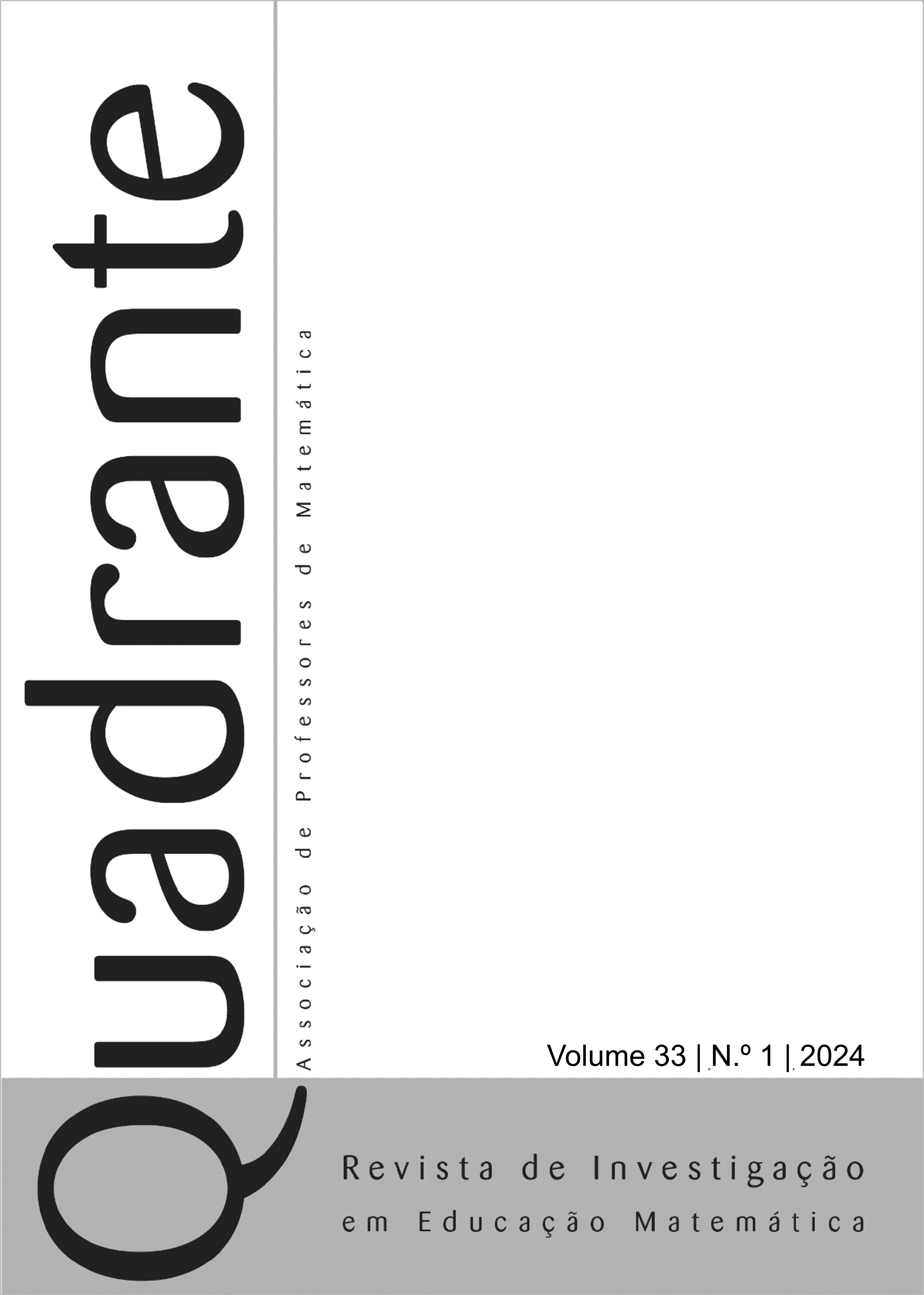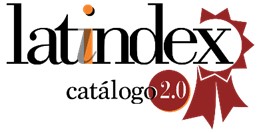How do students communicate in writing and which difficulties do they have in solving a mathematical problem?
DOI:
https://doi.org/10.48489/quadrante.33950Keywords:
written communication, problem solving, difficulties, high schoolAbstract
By the end of compulsory education, students should have developed problem-solving and written communication skills. The Portuguese curriculum emphasises these skills by encouraging students to justify their ideas and decisions and to link their arguments in an organised and coherent way. Difficulties are an integral part of this process, perceived by students when solving problems or writing their solutions. Their identification is a necessary step so that they are overcome later. Therefore, our aims are: (1) to understand how students communicate their problem-solving in writing, and (2) to identify the difficulties they experience in problem-solving and written communication. We developed a system of categories to characterise written communication and to analyse the difficulties observed in students’ resolutions. The resolutions analysed were written by six groups of 11th grade students in response to a mathematical problem presented to them. We obtained one incorrect, one partially correct and four correct resolutions, with diverse levels of justification, ranging from null to high, and with all types of justification that could be found. One of the groups did not present any difficulties, while the others had varying difficulties related to persistence, interpretation, selection of information, strategy, writing, and coherence.
References
Aineamani, B. (2018). How learners communicate their mathematics reasoning in mathematics discourse. In J. N. Moschkovich, D. Wagner, A. Bose, J. R. Mendes & M. Schütte (Eds.), Language and communication in mathematics education (pp. 65-74). Springer.
Boavida, A. M., Paiva, A. L., Cebola, G., & Pimentel, T. (2008). A experiência matemática no Ensino Básico. Ministério da Educação.
Carvalho e Silva, J., Rodrigues, A., Domingos, A., Albuquerque, C., Cruchinho, C., Martins, H., Almiro, J., Gabriel, L., Graça Martins, M. E., Santos, M. T., Filipe, N., Correia, P., Espadeiro, R. G., & Carreira, S. (2023). Aprendizagens essenciais [11º ano, Matemática A] (J. Carvalho e Silva, Coord.). Direção-Geral da Educação (DGE). https://www.dge.mec.pt/sites/default/files/Curriculo/Aprendizagens_Essenciais/mat_a_10_-_vf.pdf
Corrêa, M. L. (2013). Bases para o ensino da escrita. Linguagem em (Dis)curso, 13(3), 481-513. https://doi.org/10.1590/S1518-76322013000300003
Costa, E., & Pires, M. V. (2016). Comunicar por escrito em matemática: um estudo com alunos do 5.º ano. In M. H. Martinho, R. A. Ferreira, I. Vale & H. Guimarães (Eds.), Atas do XXVII Seminário de Investigação em Educação Matemática (pp. 405-419). APM.
Coutinho, C. P. (2011). Metodologia de investigação em Ciências Sociais e Humanas: Teoria e prática. Almedina.
Creswell, J. W., & Poth, C. N. (2018). Qualitative inquiry & research design: Choosing among five approaches (4th ed.). SAGE Pubications Inc.
Cross, D. I. (2009). Creating optimal mathematics learning environments: combining argumentation and writing to enhance achievement. International Journal of Science and Mathematics Education, 7, 905-930. https://doi.org/10.1007/s10763-008-9144-9
Goma, J. L., Manrique, A. L., & Martinho, M. H. (2020). A comunicação matemática escrita de futuras professoras dos anos iniciais do Ensino Fundamental envolvendo o pensamento algébrico. Quadrante, 29(2), 47-67. https://doi.org/10.48489/quadrante.22571
Højgaard, T. (2021). Teaching for mathematical competence: the different foci of modelling competency and problem solving competency. Quadrante, 30(2), 101-122. https://doi.org/10.48489/quadrante.23691
Kusumadewi, C. A., & Retnawati, H. (2020). Identification of elementary school students' difficulties in mathematical problem-solving. Journal of Physics: Conference Series, 1511. https://doi.org/10.1088/1742-6596/1511/1/012031
Leavy, P. (2017). Research design: Quantitative, qualitative, mixed methods, arts-based, and community-based participatory research approaches. The Guilford Press.
Lee, G. P., Lim, C. S., & Leong, L. M. (2020). Use mathematical writing as a practical approach to increase students' problem solving skills: A case study. The Mathematics Enthusiast, 1(1), 239-273. https://doi.org/10.54870/1551-3440.1486
Martinho, M. H., & Rocha, H. (2018). A escrita matemática e a intuição em Geometria. Educação e Matemática, 149-150, 34-38.
Martins, L. G. (2023). A resolução de problemas e a escrita matemática: Um estudo com alunos do ensino secundário [Tese de doutoramento]. Instituto de Educação, Universidade do Minho.
Martins, L. G., & Martinho, M. H. (2021). Strategies, difficulties, and written communication in solving a mathematical problem. Bolema, 35(70), 903-936. https://doi.org/10.1590/1980-4415v35n70a16
Mascle, D. D. (2013). Writing self-efficacy and written communication skills. Business Comunication Quarterly, 76(2), 216-225. https://doi.org/10.1177/1080569913480234
McCarthy, D. S. (2010). Communication in mathematics: Preparing preservice teachers to include writing in mathematics teaching and learning. School Science and Mathematics, 108(7), 334-340. https://doi.org/10.1111/j.1949-8594.2008.tb17846.x
Menezes, L., & Nacarato, A. M. (2020). Comunicação no ensino e na aprendizagem da Matemática. Quadrante, 29(2), 1-5. https://doi.org/10.48489/quadrante.22568
Menezes, L., Ferreira, R. A., Martinho, M. H., & Guerreiro, A. (2014). Comunicação nas práticas letivas dos professores de Matemática. In J. P. Ponte (Org.), Práticas profissionais dos professores de Matemática (pp. 135-161). Instituto de Educação da Universidade de Lisboa.
Menezes, L., Guerreiro, A., Martinho, M. H., & Tomás Ferreira, R. A. (2013). Essay on the role of teachers' questioning in inquiry-based mathematics teaching. Sisyphus - Journal of Education, 1(3), 44-75. https://doi.org/10.25749/sis.3706
Mora, D. V., & Rodríguez, N. C. (2020). Conocimiento de un profesor de Álgebra Lineal sobre los errores de los estudiantes y su uso en la enseñanza. Quadrante, 29(1), 97-114. https://doi.org/10.48489/quadrante.23008
Morgan, C., Craig, T., Schuette, M., & Wagner, D. (2014). Language and communication in mathematics education: an overview of research in the field. ZDM Mathematics Education, 46, 843-853. https://doi.org/10.1007/s11858-014-0624-9
Moschkovich, J. (2002). A situated and sociocultural perspective on bilingual mathematics learners. Mathematical thinking and learning, 4(2&3), 189-212. https://doi.org/10.1207/S15327833MTL04023_5
Moschkovich, J. (2018). Recommendations for research on language and learning mathematics. In J. N. Moschkovich, D. Wagner, A. Bose, J. R. Mendes & M. Schütte (Eds.), Language and communication in mathematics education (pp. 37-47). Springer.
Neuman, W. L. (2014). Social research methods: Qualitative and quantitative approaches (7th ed.). Pearson Education Limited.
OECD. (2014). PISA 2012 results: Creative problem solving - Students' skills in tackling real-life problems (Volume V). https://www.oecd.org/pisa/keyfindings/PISA-2012-results-volume-V.pdf
Pantaleon, K. V., Juniati, D., Lukito, A., & Mandur, K. (2018). The written mathematical communication profile of prospective math teacher in mathematical proving. Journal of physics: Conference series, 947, 1-6. https://doi.org/10.1088/1742-6596/947/1/012070
Phonapichat, P., Wongwanich, S., & Sujiva, S. (2014). An analysis of elementary school students' difficulties in mathematical problem solving. Procedia - Social and Behavioral Sciences, 116, 3169-3174. https://doi.org/10.1016/j.sbspro.2014.01.728
Ponte, J. P., & Quaresma, M. (2020). Exploratory mathematics teaching and the development of students' use of representations and reasoning processes: An illustration with rational numbers. In L. Leite (Eds.), E. Oldham, A. S. Afonso, F. Viseu, L. Dourado & M. H. Martinho, Science and mathematics education for 21st century citizens: Challenges and ways forward (pp. 131-148). Nova Science Publishers, Inc.
Ponte, J. P., Quaresma, M., & Branco, N. (2012). Tarefas de exploração e investigação na aula de matemática. Educação Matemática em Foco, 1(1), 9-29.
Prates, A., Tavares, C., Dias, R. P., & Nunes, C. C. (2011). O pensamento algébrico no estudo das funções no 10.º ano de escolaridade. In A. Henriques, C. Nunes, A. Silvestre, H. Jacinto, H. Pinto, A. Caseiro & J. P. Ponte (Orgs.), Atas do XXII Seminário de Investigação em Educação Matemática (pp. 163-178). APM.
Pugalee, D. K. (2001). Writing, mathematics, and metacognition: Looking for connections through students' work in mathematical problem solving. School Science and Mathematics, 101(5), 236-245. https://doi.org/10.1111/j.1949-8594.2001.tb18026.x
Sáenz-Ludlow, A., & Kadunz, G. (2016). Constructing knowledge seen as a semiotic activity. In A. Sáenz-Ludlow & G. Kadunz (Eds.), Semiotics as a tool for learning mathematics (pp. 1-21). SensePublishers.
Santos, L., & Semana, S. (2015). Developing mathematics written communication through expository writing supported by assessment strategies. Educational Studies in Mathematics, 88(1), 65-87. https://doi.org/10.1007/s10649-014-9557-z
Schoenfeld, A. H. (1985). Mathematical problem solving. Academic press, inc.
Socas, M. M. (2007). Dificultades y errores en el aprendizaje de las matemáticas análisis desde el enfoque lógico semiótico. In M. Camacho, P. Flores, & M. P. Bolea (Eds.), Investigación en educación matemática (19-52). Sociedad Española de Investigación em Educación Matemática (SEIEM).
Stake, R. E. (2016). A arte da investigação com estudos de caso (4a ed.). Fundação Calouste Gulbenkian.
Stein, M. K., Grover, B. W., & Henningsen, M. (1996). Building student capacity for mathematical thinking and reasoning: An analysis of mathematical tasks used in reform classrooms. American Educational Research Journal, 33(2), 455-488.
Tambychik, T., & Meerah, T. S. (2010). Students' difficulties in mathematics problem-solving: What do they say? Procedia Social and Behavioral Sciences, 8, 142-151. https://doi.org/10.1016/j.sbspro.2010.12.020
Thao, N. P., & Trinh, L. T. (2018). Some obstacles in mathematical communication of students while learning continuous functions lesson. Proceedings of 6th Asian Academic Society International Conference (AASIC), 389-402.
Wijaya, A., van den Heuvel-Panhuizen, M., Doorman, M., & Robitzsch, A. (2014). Difficulties in solving context-based PISA mathematics tasks: An analysis of students' errors. The Mathematics Enthusiast, 11(3), 555-584. https://doi.org/10.54870/1551-3440.1317
Yuniara, P., Sinaga, B., & Dewi, I. (2018). Analysis of difficulties in completing mathematical communication problem solving in terms of learning styles using inquiry learning. Advances in Social Science, Education and Humanities Research, 200, 764-768. https://doi.org/10.2991/aisteel-18.2018.166











